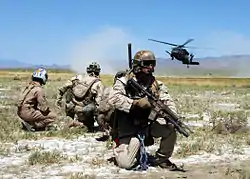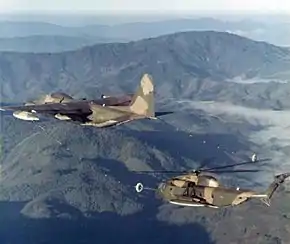Combat search and rescue
Combat search and rescue (CSAR) are search and rescue operations that are carried out during war that are within or near combat zones.[1]

A CSAR mission may be carried out by a task force of helicopters, ground-attack aircraft, aerial refueling tankers and an airborne command post.[2] The USAF HC-130, which was introduced in 1965, has served in the latter two roles.[3]
History

The First World War was the background for the development of early combat search and rescue doctrine, especially in the more fluid theaters of war in the Balkans and the Middle East.
In the opening fluid stages of the First World War the Royal Navy Air Service Armoured Car Section was formed with armed and armoured touring cars to find and pick up aircrew who had been forced down. When trench warfare made this impossible the cars were transferred to other theatres, most notably the Middle East.
In 1915, during the First World War, Squadron Commander Richard Bell-Davies of the British Royal Naval Air Service performed the first combat search and rescue by aircraft in history. He used his single-seat aeroplane to rescue his wingman who had been shot down in Bulgaria. His Victoria Cross citation included "Squadron-Commander Davies descended at a safe distance from the burning machine, took up Sub-Lieutenant Smylie, in spite of the near approach of a party of the enemy, and returned to the aerodrome, a feat of airmanship that can seldom have been equalled for skill and gallantry."[4] Like the search and rescue efforts of the future, Davies' action sprang from the fervent desire to keep a compatriot from capture or death at the hands of the enemy.
It was during the Mesopotamian campaign that British and other Commonwealth forces began to use similar tactics on a larger scale. Shot down aviators in hostile Bedouin territory were often located by search parties in the air and rescued.[5]
Other nations also contributed to the development of modern-day CSAR. During World War II, the Luftwaffe (Seenotdienst organization) operated armed camouflaged air-sea rescue aircraft.[6]
In the First Indochina War French doctor, pilot and parachutist Valerie Andre pioneered MEDEVAC tactics, a precursor to what we know as CSAR today, by flying helicopters into combat zones to retrieve (or sometimes treat) injured soldiers.
In August 1943 a wing flight surgeon, Lt. Col. Don Flickinger, and two combat surgical technicians, Sgt. Richard S. Passey and Cpl. William G. MacKenzie, parachuted from the search planes in the Naga area of Burma to assist and care for the injured.[7] At the same time, a ground team was sent to their location and all twenty walked to safety.
Although parachute rescues were not officially authorized at the time, this is considered by PJs to be the birth of United States Air Force Pararescue. Eric Sevareid said of his rescuers: "Gallant is a precious word: they deserve it". A few short months later, Capt. Porter was killed on a rescue mission when his B-25 was shot down.

During the Vietnam War the costly rescue of Bat 21 led the US military to find a new approach to high-threat search and rescue. They recognized that if a SAR mission was predestined to fail, it should not be attempted and other options such as special operations, diversionary tactics and other creative approaches tailored to the situation had to be considered. Recognizing the need for an aircraft that could deliver better close air support, the US Air Force introduced the A-7 Corsair, originally a carrier-based Navy light attack aircraft, to replace the Air Force's A-1 Skyraiders, an aircraft that also was originally a carrier-based naval attack bomber.
As a result of the Vietnam CSAR experience, the US military also improved the night capability of helicopters and area denial munitions.[8]:36
During the Vietnam War, U.S. SAR forces saved 3,883 lives at the cost of 71 rescuers and 45 aircraft.[8]:46
Notable CSAR missions
World War One
On 21 April 1917, Captain Richard Williams of the Australian Flying Corps landed behind enemy lines to rescue a downed comrade.[9][10]
Vietnam War
In 1972, during the Vietnam War, Lt Col Iceal Hambleton, a USAF navigator/electronic warfare officer with a background in ballistic missile technology and missile countermeasures, was the sole survivor of an EB-66 shot down during the Easter Offensive. He eluded capture by North Vietnamese forces until his rescue 11½ days later. During the rescue operation, five US military aircraft supporting the CSAR effort were shot down, eleven US servicemen were killed and two men were captured. The rescue operation was the "largest, longest, and most complex search-and-rescue" operation during the entire Vietnam War.[11] It has been the subject of two books and the largely fictionalized film Bat*21.[12]
Others

The United States Air Force (USAF) 24th Special Tactics Squadron was involved in the 1993 Battle of Mogadishu.[13] Timothy Wilkinson, a Pararescueman, was awarded the Air Force Cross for his heroic actions during the battle.[14]
Air Force pararescue personnel (PJs) have been awarded one United States Air Force Medal of Honor and 12 Air Force Cross's since the Southeast Asia conflict.
During the opening moments of Operation Desert Storm, an MH-53 Pave Low crew from the 20th Special Operations Squadron recovered an F-14 Tomcat pilot who was shot down over Iraq.[15]
On June 2, 1995, a USAF F-16C was shot down by a Bosnian Serb Army SA-6 surface-to-air missile near Mrkonjić Grad, Bosnia and Herzegovina. The American pilot, Scott O'Grady, ejected safely and was rescued six days later.[16] The operation became known as the Mrkonjić Grad incident.
In 1999, members of United States Air Force Pararescue along with Air Force Special Operations recovery aircraft successfully rescued the pilot (Vega 31) of an F-117 "stealth" attack aircraft and the pilot (Hammer 34) of an F-16 fighter aircraft both of whom were shot down over Yugoslavia while on a NATO-led mission. Both pilots were rescued following each isolating event.[17]
See also
References
- SPG Media Limited/Army-Technology.com (2009). "Term: Combat Search and Rescue". Archived from the original on 2008-05-10. Retrieved 2009-06-03.
- Combat Aircraft (European Edition) (magazine), Ian Allan Publishing, September 2003, page 28
- Combat Aircraft (European Edition) (magazine), Ian Allan Publishing, September 2003, page 29
- "No. 29423". The London Gazette (Supplement). 1 January 1916. p. 86.
- Leave No Man Behind: The Saga of Combat Search and Rescue. pp. 5–6.
- Feltus, Pamela. History and the Headlines. "Air-Sea Rescue." ABC-CLIO, 2008. Retrieved: 23 April 2011.
- Sevareid, Eric (28 August 1943). "Burmese Headhunters Saved Lives of Stranded Fliers". St. Petersburg Times. Retrieved 8 November 2020.
- Busboom, Lt. Col. Stanley (April 2, 1990). Bat 21: A Case Study. Carlisle Barracks, Pennsylvania: U.S. Army War College. Retrieved April 3, 2011.
- Cutlack, The Australian Flying Corps, p.63
- "No. 30234". The London Gazette (Supplement). 14 August 1917. p. 8353.
- Zimmerman, Dwight Jon; Gresham, John (14 October 2008). Beyond Hell and Back: How America's Special Operations Forces Became the World's Greatest Fighting Unit. St. Martin's Griffin. p. 320. ISBN 978-0-312-38467-8.
- Darrel D. Whitcomb, The Rescue of Bat 21 (Naval Institute Press, 1998)
- Pike, John (n.d.). "24th Special Tactics Squadron 24th STS". Global Security. Retrieved 19 April 2011.
- "The Air Force Cross For Actions in Somalia in 1993". Archived from the original on November 4, 2016. Retrieved September 7, 2012.
- "Hawg Driver Coordinates Desert Storm Rescue Mission! - Fighter Sweep". 1 February 2016.
- "One Amazing Kid - Capt. Scott O' Grady escapes from Bosnia-Herzegovina". Archived from the original on 2011-06-08.
- Valdet. "U.S. F-117 Stealth Fighter Is Downed in Yugoslavia".
External links
| Wikimedia Commons has media related to Combat Search and Rescue. |